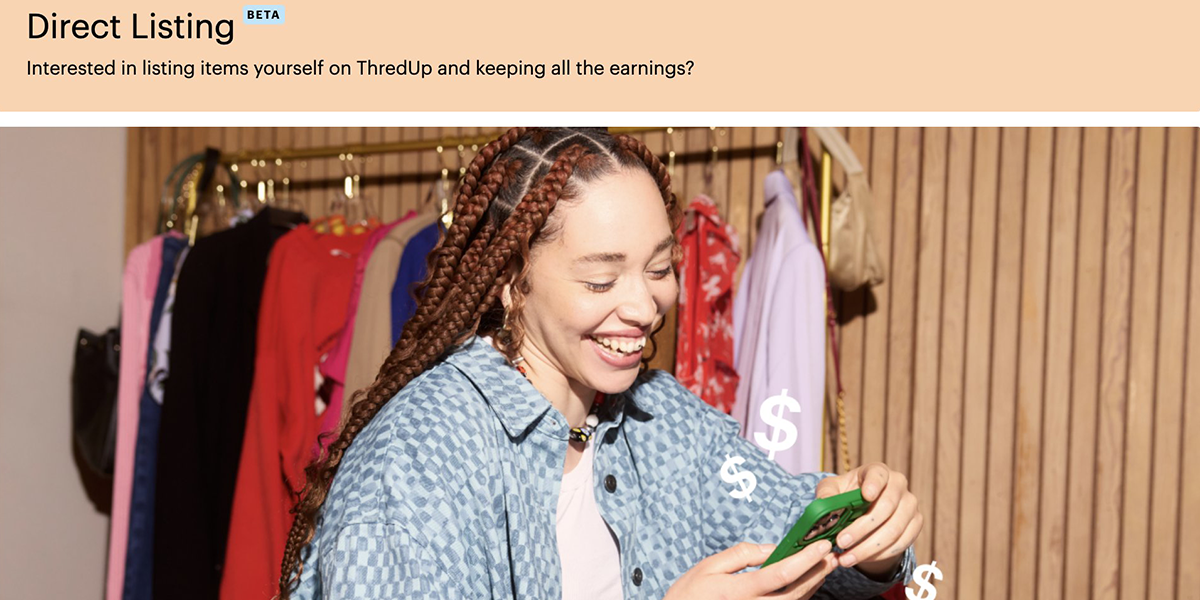ThredUp has quietly launched a peer-to-peer marketplace

Secondhand apparel platform ThredUp is testing out a brand-new peer-to-peer resale marketplace that takes direct aim at competitors like Poshmark, Mercari and Depop.
It’s unclear when exactly the new marketplace debuted, but it’s easy enough to find on ThredUp’s website. (The marketplace doesn’t appear as an option on mobile web or ThredUp’s app.) If a user clicks on the “Sell” tab on ThredUp’s homepage, the toolbar at the top includes a new “Direct Listing” link that is labeled as “new” in eye-catching yellow font. From there, users can click on the link and learn about how to enroll in the program, which is currently in beta, according to the website. When a user tries to enroll, they are added to a waiting list. It’s unclear if any buyers or sellers have access to the marketplace yet.
The marketplace appears to still be under wraps, as ThredUp hasn’t posted about direct listing on any official channels. It was spotted by Danielle Vermeer, the founder of a thrifting app called Teleport.
“ThredUp revolutionized the selling experience for thrifters when we pioneered the cleanout kit more than a decade ago,” a ThredUp spokesperson said in a statement to Modern Retail. “As innovators in the resale industry, we are always exploring new ways to offer the most convenient and rewarding selling experience for everyone.”
The peer-to-peer format marks a significant departure from ThredUp’s business model. Currently, ThredUp stocks and sells used clothing that it gets from either brands themselves or consumers who mail in their unwanted clothes. With this new direct listing capability, ThredUp functions more like Poshmark. How it works is sellers take photos of the items they want to sell and upload all the item details, including size, price and brand. The item remains listed until it sells, according to ThredUp’s website. Once an item is sold and shipped out with a prepaid shipping label, sellers can either earn store credit at ThredUp or cash out.
“They are between a rock and a hard place in terms of where to evolve their business,” said Juan Pellerano-Rendón, chief marketing officer at e-commerce logistics startup Swap. “This is another way to see where they can focus and create a new revenue stream for them.”
Notably, ThredUp’s peer-to-peer marketplace is advertising no selling fees — while it’s in beta mode, at least. Meanwhile, Poshmark charges a flat fee of $2.95 for items sold for $15 or less on its platform or 20% of the total amount for orders that exceed $15. In March, Mercari eliminated seller fees on its platform. (Previously, the platform had a 10% flat commission for every sale made on the platform. ) In July, London-based Depop removed its 10% selling fee for users based in the U.S., though the platform still charges a payment processing fee of 3.3% plus $0.45.
For ThredUp’s standard services, the company charges $14.99 for each bag customers mail in, but only if their items sell. That’s on top of the cut that ThredUp takes from each sold item, which depends on the final selling price. Generally, sellers get to keep a higher percentage of their earnings for pricier items. For example, sellers earn 80% for items that sell for more than $200. In contrast, sellers earn between 3% and 15% for items that sell between $5 and $19.99, according to the website.
To Marc Viale, former chief growth officer at The RealReal and founder of growth accelerator company LAB415, ThredUp’s foray into peer-to-peer resale is a step towards a more profitable business model — something ThredUp has struggled with for years. That’s because peer-to-peer marketplaces don’t have to pay for warehouses or photographers because sellers list and ship their own items. Platforms like Rebag and The RealReal can afford such overhead costs because they specialize in expensive luxury goods. ThredUp, meanwhile, carries clothes from a variety of companies including lower-priced, mid-tier brands like Zara and Madewell.
“ThredUp has a more expensive model, which puts them at a disadvantage on commission fees because they have to take a bigger cut to pay for receiving, fulfilling and warehousing of the goods,” said Viale.
Although ThredUp’s revenue rose to a record $322 million last year, the company still recorded a net loss of $71 million. ThredUp’s stock has lost more than 90% of its value since the retailer went public in 2021.
ThredUp’s peer-to-peer marketplace comes just a couple of weeks after the company revealed during its second-quarter earnings that it plans to exit the European market, as well as explore strategic alternatives for its Remix business. ThredUp acquired Remix, a Bulgaria-based secondhand apparel company for more than $28 million in 2021.
It was only in May that ThredUp appointed Florin Filote as general manager of Europe. “We’ve made great strides in growing our European business since entering the market in 2021, more than doubling our revenue and evangelizing secondhand across Central and Eastern Europe,” ThredUp CEO James Reinhart said at the time. But during second-quarter earnings, ThredUp’s European business saw revenues decline 18% compared to the same period last year. Revenue in the U.S. was flat.
With more than 1.6 million active buyers and orders, according to the company’s second-quarter earnings, ThredUp should focus on growing at home in the U.S. market, said Viale. “They probably went into Europe thinking it would be a way to leapfrog and get a whole audience of folks over there,” said Viale. “But there’s so much more to capture here in the U.S., and there’s so many players over there in Europe.”
A peer-to-peer marketplace could be the way for ThredUp to course correct. As Viale put it, “that is the right direction.”
